The Four Maharajas
In the teachings of the Secret Doctrine, the Four Maharajas, also known as the Four Great Lords or Regents of the Elements, are exalted Deva Lords who stand as the spiritual rulers and governors of the four cosmic elements: earth, water, air, and fire. These mighty beings serve under the direction of the planetary Logos, Sanat Kumara, acting as the supreme agents of karmic law within the three worlds of human evolution, physical, emotional, and mental. Their work is closely associated with the administration of divine justice and equilibrium, maintaining the balance between the forces of creation and destruction within the manifested universe. The Maharajas function in alignment with the karmic lords (the Lipika Lords), executing their decrees and ensuring that the forces of nature and the elemental lives remain in harmony with the greater Plan.
“Regents of the Four Cardinal Points.”
H. P. Blavatsky adopts the universal idea of Four Maharājas as cosmological Regents, connecting them with the “Lipikas” (recorders) and the moral architecture of karma. In The Secret Doctrine she notes the cross-cultural ubiquity of belief in Four Regents and explains that their specific terrestrial “application” is karmic: they “produce karmic effects,” are “posted at the four corners of the world” to inscribe deeds in the astral light, an esoteric image for the inevitability and precision of moral causation. Read this not as folk demonology but as poetic metaphysics: each “quarter” mirrors a law of balance that keeps the universe morally intelligible
In Hindu tradition the Four Maharājas are not only mythic “direction-keepers” but a spatial ethic: courage (East), conscience (South), order (West), and stewardship (North). Blavatsky’s theosophic reading intensifies this as a karmic compass, where every quarter of our living records and re-balances causes. To “orient” one’s day by them is to make the world a little more luminous, just, and generous, one sunrise, one vow, one boundary, and one gift at a time.
In Hindu cosmology the cardinal directions are “kept” by four gods: Indra governs the East, Yama the South, Varuṇa the West, and Kubera the North. This directional guardianship appears across Purāṇic and ritual sources and is also reflected in architecture and sacred space design (vastu).
Indra - East
Indra — East — Awakening courage and right use of power
In the Veda, Indra is the most-sung deity, famed for slaying Vṛtra, releasing the life-waters and clearing the way for light and rain, myths that encode his role as remover of obstruction and restorer of order. Spiritually, “Indra of the East” signals dawn, initiative, and the courage to break inner inertia for the sake of the common good. A contemplative Indra-quality is disciplined strength: power yoked to service, not appetite. In practice, one “faces East” (literally or inwardly) to invoke clarity at beginnings, of a day, a work, or a vow, asking for valor that liberates vitality for all.
Yama - South
Yama — South — Conscience, limits, and just passage
Yama is the ruler of the departed, often called Dharmarāja (Lord of Dharma). In early Vedic thought he is the first mortal who found the path to the celestial realm and so becomes guardian of the way; later he judges, measures, and sets limits. Spiritually, Yama educates the heart in accountability: mortality as the teacher of meaning, conscience as the guardian of the threshold. Practices aligned with Yama include reviewing one’s day (truthfulness, repair, forgiveness) and dedicating merit for the dead, turning limitedness into love.
Varuna - West
Varuṇa — West — Cosmic order (ṛta), oath, and the waters of compassion
Varuna is the venerable Vedic upholder of Rta (cosmic/moral order) and the lord of the waters. He binds wrongdoing with his “noose,” not as vengeance but as the inescapable lawfulness of reality; he also pardons when order is restored. Spiritually, Varuṇa invites us to live by our word, steward emotions like water (deep, clear, life-giving), and align personal rhythm with universal law. Evening practices (the West) include truth-telling, vow renewal, and “returning to the ocean”, softening the heart and re-entering the great current.
Kubera - North
Kubera — North — Stewardship of resources and generosity
Kubera, king of the yakṣas and God of wealth, guards the treasures of earth and mountains and is Regent of the North. In spiritual terms, Kubera’s wealth is not greed but right circulation: provisioning what serves dharma, time, attention, skill, money, so that goodness can flow. Living Kubera means practicing sufficiency, fair exchange, and planned generosity; it also means un-hoarding inner riches (talents, friendship, knowledge). Iconography often shows Kubera with a money-pot and club; he is closely tied to abundance myths and even the legendary flying chariot (puṣpaka), symbolizing the right movement of resources.
Blavatsky’s usage does not replace the Hindu deities but reframes their guardianship as a living karmic ecology:
- East/Initiation (Indra): the karmic release of obstructed forces through right action.
- South/Justice (Yama): the weighing of motives and consequences.
- West/Order (Varuna): the restoration of Rta (Cosmic Order)—promises kept, harmony repaired.
- North/Provision (Kubera): the equitable circulation of energies/treasures in service of the whole.


